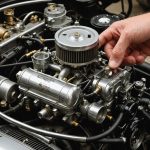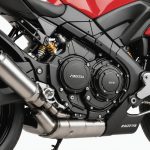Essential Tools for Carburetor Cleaning and Tuning
Maintaining the carburetor of a KZ1000 demands precision and the right set of carburetor cleaning tools. Utilizing the proper tools not only ensures optimal performance but also extends the life of the motorcycle.
For a comprehensive cleaning, a carburetor cleaning kit is indispensable. This kit typically includes brushes and needles specifically designed to reach the tiny passages within the carburetor. Brands like Motion Pro and BikeMaster are renowned for their sturdy and thorough cleaning capabilities. Additionally, a high-quality ultrasonic cleaner can effectively remove stubborn grime.
This might interest you : Essential Tips for Caring for the Belt Drive System of Your Harley-Davidson Softail Slim
KZ1000 maintenance tools aren’t complete without a range of screwdrivers and wrenches. These tools must be precisely sized to avoid damaging the carburetor’s delicate components. When tuning, a synchronizer is also advisable to balance the carburetor cylinders accurately, ensuring smooth engine performance.
Safety is paramount during maintenance. Protective gear such as gloves and goggles shield from hazardous cleaning agents. Always work in a well-ventilated area to minimize exposure to harmful fumes, and ensure any power tools are correctly grounded to prevent accidents.
Topic to read : Exploring the Advantages of Upgrading Your Honda VFR800 Exhaust System for Ultimate Touring Performance
Selecting top-tier tools and observing safety protocols paves the way for successful KZ1000 carburetor maintenance, enhancing both performance and longevity.
Step-by-Step Guide to Cleaning Carburetors
Cleaning your carburetor is crucial for the optimal performance of your motorcycle, notably models like the KZ1000. This guide walks you through the entire carburetor cleaning process, ensuring effective maintenance.
Preparing Your Work Area
Ensure your workspace is clean, well-lit, and free of any potential contaminants. Secure bits and pieces in labeled containers to avoid confusion during reassembly. This level of organisation is key for efficient KZ1000 carburetor maintenance.
Disassembling the Carburetor
Disassemble the KZ1000 carburetor with precision. Keep track of components as you safely remove them and make sure to remember their order for later reassembly. Using appropriate tools to prevent damage and avoid forced removals is crucial here.
Cleaning Techniques
Once disassembled, immerse the parts in a recommended carburetor cleaner designed for motorbikes, paying close attention to hard-to-reach areas. A gentle bristle brush can aid in removing residues, whilst compressed air assists in thorough drying. For the KZ1000, proper disassembly techniques and careful drying are necessary to ensure all components are spotless and moisture-free.
Reassemble meticulously, following your disassembly steps in reverse. Regular maintenance following these techniques ensures a well-performing motorcycle. For the KZ1000, precision during cleaning and reassembly keeps your ride running smoothly.
Tuning Procedures for Optimal Performance
Getting the best performance from the KZ1000 requires precise adjustment and knowledge of the carburetor tuning process. This process ensures that the engine burns fuel efficiently, enhancing both power and fuel economy.
Understanding Air-Fuel Mixture
The air-fuel mixture is critical for engine performance. A balanced blend results in optimal combustion, providing more power and efficiency. Tools such as an air-fuel ratio meter can help measure the mixture accurately. If the mixture is too rich (more fuel than air), it can lead to poor fuel economy and increased emissions. Conversely, a lean mix (more air than fuel) might cause engine knocking. Maintaining the right balance is essential for a smooth ride.
Adjusting the Idle and Throttle
Adjusting idle speed and throttle response are vital components of the KZ1000 tuning tips. Begin by setting the idle speed using the idle adjustment screw, ensuring the engine runs smoothly at low RPMs. Fine-tuning the throttle ensures quick response and power delivery. Use a synchronized approach for all cylinders to prevent inconsistencies.
Fine-Tuning for Performance
Key adjustments such as tweaking the carburetor jets can significantly impact performance. To maximize the KZ1000’s potential, regularly check these settings. Avoid common mistakes like neglecting to check the spark plugs or overlooking air filter maintenance. These simple checks can prevent major issues and prolong engine life.
Troubleshooting Common Carburetor Issues
Encountering carburetor problems with your KZ1000 can be a frustrating experience. Understanding and identifying these issues early can save time and prevent further complications.
Symptoms of carburetor malfunctions often include irregular engine idling, poor fuel efficiency, and difficulty starting the engine. If you notice these indicators, it’s time to inspect your carburetor more closely. Common KZ1000 issues also involve sputtering and stalling, which often result from clogged jets or improper air-fuel mixtures.
For quick fixes, first, inspect for visible dirt or blockage. Occasionally, a simple cleaning can resolve the problem. Use a compressed air canister to blow out debris from the jets. It’s essential to ensure that the air filters are clean and that fuel lines are free of obstructions. Another potential solution is adjusting the idle mixture screw to achieve the optimal air-fuel ratio.
However, certain scenarios warrant professional help. If the issue persists after attempting these solutions or you suspect complex repairs such as diaphragm replacement or float adjustment, it is advisable to consult a mechanic. They have the expertise to troubleshoot comprehensive issues and ensure your KZ1000 runs smoothly.
Maintenance Tips for Longevity
Consistent carburetor maintenance is imperative for the optimal performance of your KZ1000. Integrating this into your maintenance schedule can prevent many potential issues.
Regular Inspection Routines
Begin with routine inspections of critical components, focusing on fuel line checks and carburetor maintenance. These inspections should be more frequent if the motorcycle is used often or in harsh conditions. Routine checks ensure that dirt and debris are not present, which can cause blockages or inefficiencies.
Seasonal Maintenance Checklist
A thoughtful maintenance schedule must address seasonal changes. Begin by draining old fuel and replacing it with fresh, treated fuel before significant temperature shifts. This keeps the carburetor clean and maintains a stable fuel system. Adjusting oil levels and tire pressure also falls within necessary tasks, addressing temperature-related contractions and expansions.
Best Practices for Storage
When storing the KZ1000 for extended periods, prep it thoroughly to sustain its longevity. Begin with filling the tank fully and adding a fuel stabilizer, which protects the interior from rust. Safeguarding your KZ1000 during inactivity also involves battery removal or connection to a trickle charger, ensuring it’s ready for action after long rest periods. Always cover the bike to protect against dust and moisture while in storage.











